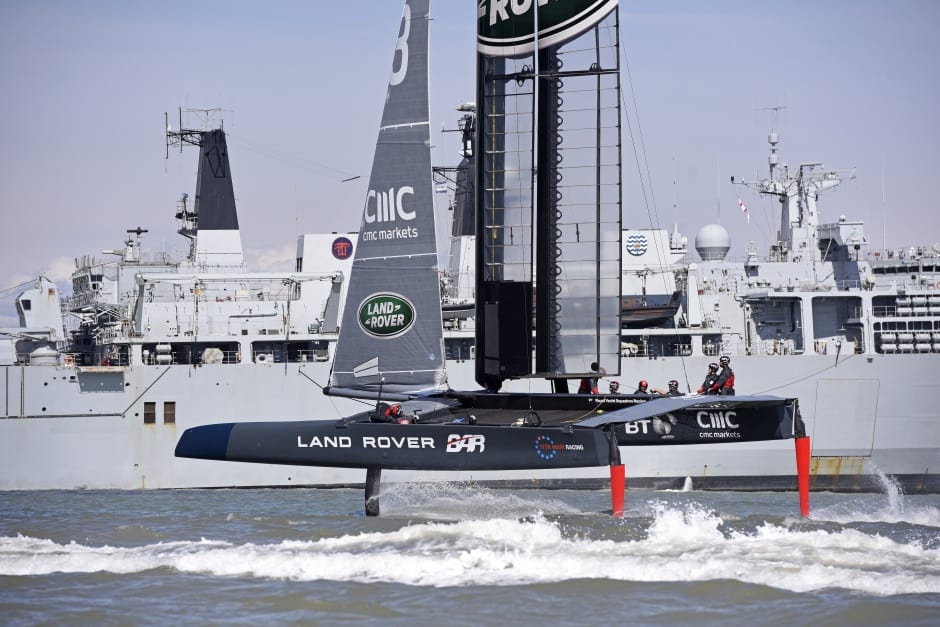
Photo: Rick Tomlinson/Land Rover BAR
If you’re interested in boats there are few more fascinating places to while away the hours than Portsmouth harbour: where an endless flotilla of superyachts, passenger ferries, towering warships and even the occasional hovercraft form what’s surely the UK’s most varied and dynamic maritime landscape.
But of all the vessels that head in and out of this historic port there is perhaps one that catches the eye more than any other: its futuristic curves, giant fibreglass sail, elegant hydrofoils, and energetic crew marking it out as something special.
For Portsmouth is the home of Land Rover BAR (Ben Ainslie Racing), the company set up by the four times Olympic sailing champion with the specific intention of bringing sailing’s most prestigious trophy – the America’s Cup – back to Britain. And the boat currently under development at the team’s sparkling new HQ is one of the most advanced, high-tech racing vessels ever to be built in the UK.
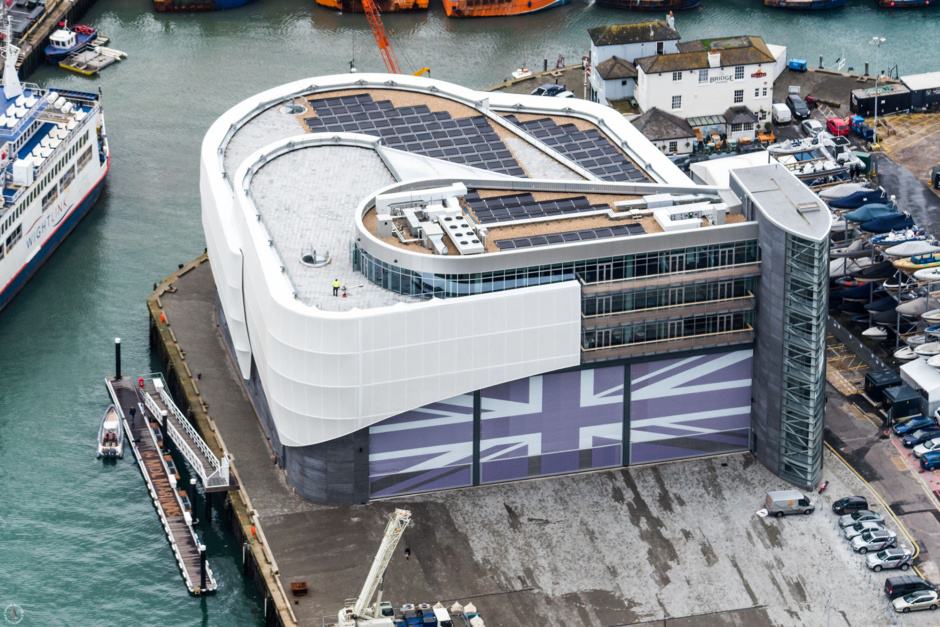
If Ainslie succeeds, it won’t be his first taste of cup success. In 2013, he was parachuted in to Oracle Team USA’s flagging campaign, and has been widely credited with masterminding one of the event’s great turnarounds: with Ainslie onboard, Oracle turned an 8-1 deficit into a 9-8 victory.
If we could bring the cup home it would be one of the greatest achievements in British sport - Ben Ainslie
But talking to The Engineer earlier this summer, Ainslie explained how this triumph only sharpened his desire to mount a proper British challenge for the trophy. “It started here in around 1851, an American boat won it, took it back to New York harbour renamed it the America’s Cup and we’ve never seen it since. It’s very important to us to right that wrong in our maritime sporting history. If we could bring the cup home it would be one of the greatest achievements in British sport.”
With this in mind, he has pulled together a crack technical team of engineers from a multitude of disciplines – led by Formula One (F1) veteran and former McLaren Group CEO Martin Whitmarsh – that he hopes will not only wrestle the iconic trophy from its current owners, but also mimic the success of firms such as McLaren and use sporting triumph as a springboard for wider industrial success.
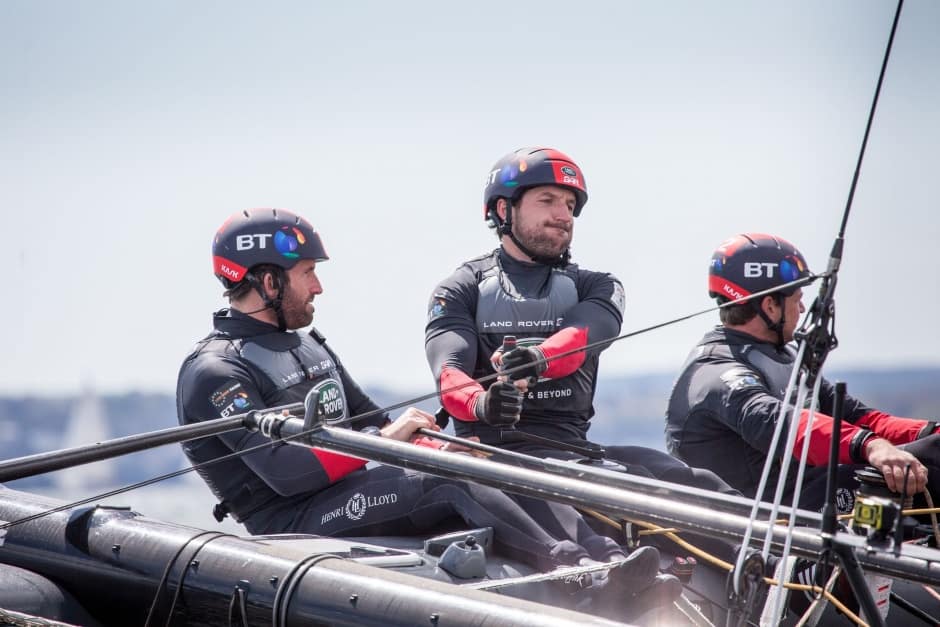
A complex competition (see box, p24), The America’s Cup has long been one of sailing’s most captivating spectacles but, over the last decade, radical changes to the rules have seen it evolve into one of sailing’s most dramatic and high-tech competitions.
As recently as 2007, competitors raced far out at sea in big mono-hull vessels typically weighing around 25 tonnes, and rarely exceeding speeds of around 10 knots. But a change in regulations for the 34th Cycle of the America’s Cup, which came to its conclusion in September 2013, saw the introduction of advanced hydrofoiling catamarans that fly at up to three times the speed of the wind on advanced L-shaped hydrofoils (or daggerboards).
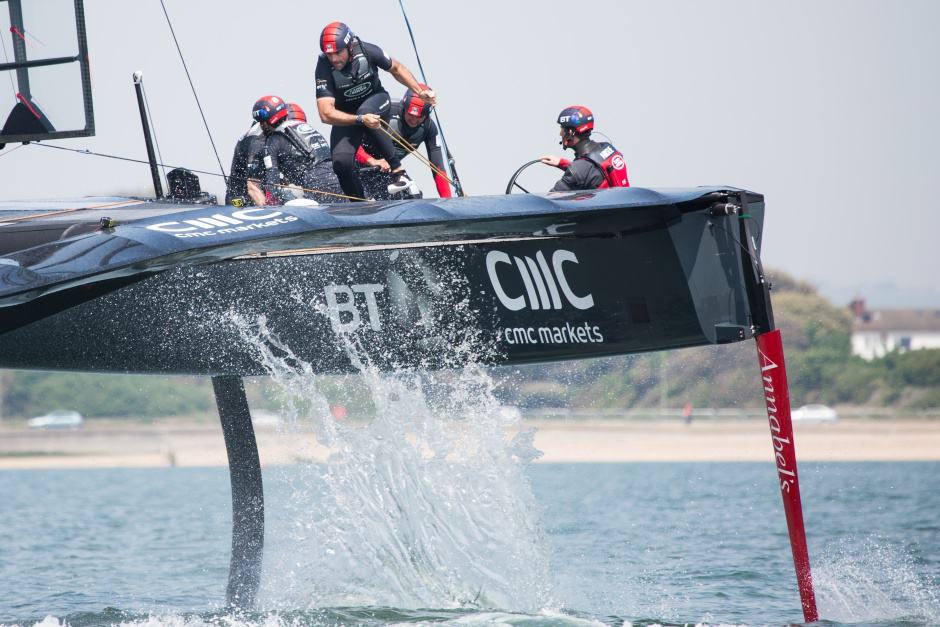
According to Ainslie, these changes have revolutionised the sport: “They’re the most incredible boats to be on; they’re so physical but the reward for getting up on the foils, tearing round at close to 60mph and doing these foiling tacks and gybes it’s just awesome. As sailors we love it and for spectators it really, really works.”
Piloting a so-called ‘foiling multihull’ around the twists and turns of an America’s Cup course is no mean feat. During sailing, the aerofoil (or wing) – a giant 23.7m-tall fibre-glass structure – provides astonishing amounts of thrust but in doing so provides an unwanted heeling force that threatens to capsize the vessel. The hydrofoils resist this side force and create the lift.
The crew’s job is to ensure that, in the constantly changing conditions of the ocean these competing forces are carefully balanced. They do this chiefly by changing the angle of attack of the hydrofoils and adjusting the wing and the flaps to generate just the right amount of thrust without capsizing the boat.
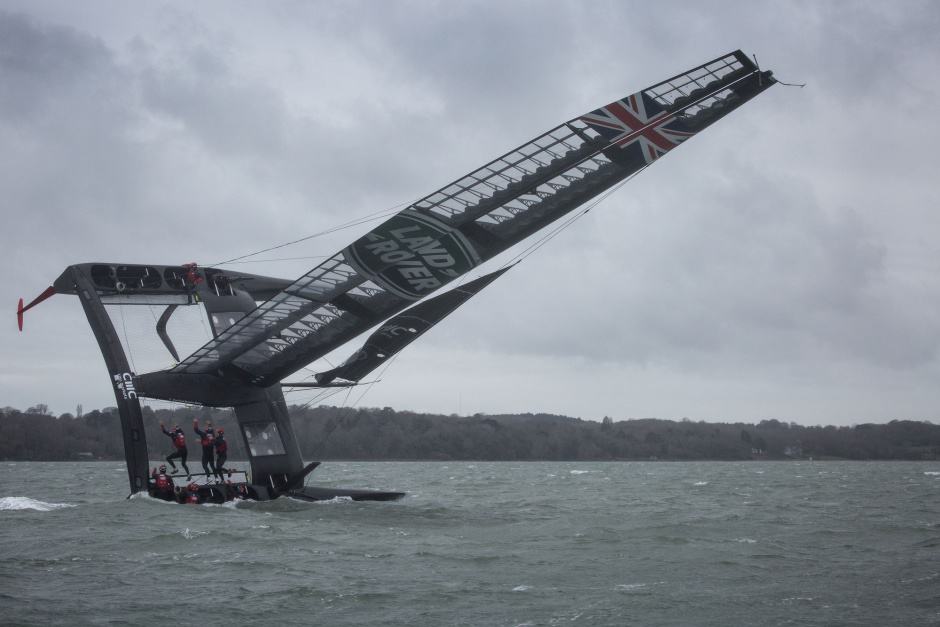
All of this is backed up by the efforts of the muscle-bound ‘grinders’: specialist crew members whose prime purpose is to operate hand-powered cranks that charge the hydraulic systems used to power the wing and foils.
The preliminary stage of the competition – the so-called Luis Vuitton America’s World Cup Series – is already under way. And for these races, which are aimed at narrowing down the field to find a challenger for next year’s big show-down in Bermuda, all of the teams are racing a standard boat: a 45ft foiling catamaran known as the AC45.
But in tandem with this the team is refining and building the considerably more advanced AC-class race boat that it hopes will eventually win the America’s Cup in Bermuda in 2017. And while the AC45 is capable of an impressive turn of speed, the AC-class vessel currently under development is estimated to be almost 2.5 times as powerful: capable of flying at around 85kph, and at up to three times the speed of the wind.
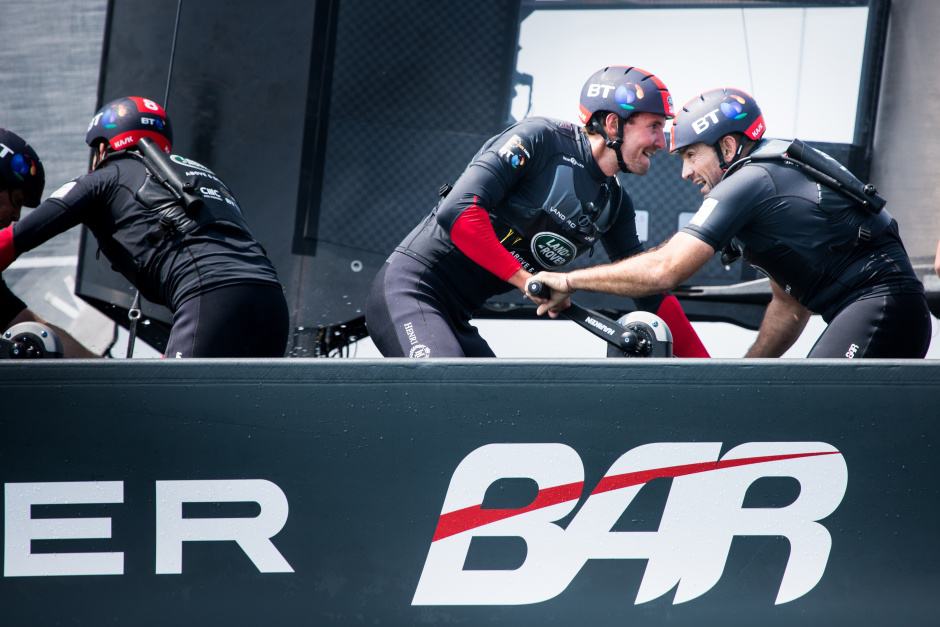
While many elements of the boat’s design are carefully regulated there are areas of design freedom – notably in the design of the hydrofoils, aerofoils (wing) and control systems. And it’s here that the engineering team hopes to squeeze out the kind of marginal gains that have come to define other high-tech racing sports. “The control of the wing, the flying shape of the wing, the dagger boards, the rudders, they’re the things that really make a difference to these boats and they’re still completely open,” explained team CEO Martin Whitmarsh.
Much of the effort has been focused on the design of the hydrofoils and ensuring that the need for speed is carefully balanced with the requirement for controllability. “We can design foils that are quicker in a straight line,” explained the team’s design manager Simon Schofield, “but it’s about striking a balance between controllability and speed now.”
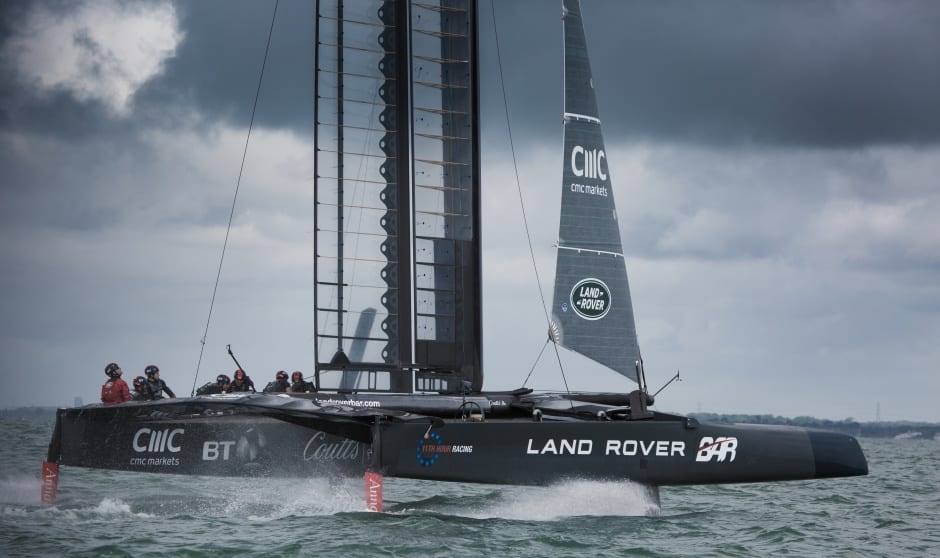
In contrast to the lengthy courses that have dominated the America’s Cup in the past, today’s finals are hectic, high speed and relatively short affairs. The Sound of Bermuda, where the final will be contested in 2017, is a tight course, where 90 per cent of the time the boat will be accelerating or decelerating and any mistake could be costly. “If you come off your foils in a gybe… and land in the water that’s [the equivalent to] 10 or 15 boat lengths, and in some races if you touch down once in a gybe you lose the race,” said Schofield. “It’s a balance between having the quickest possible foil and one that can get around the course. The boundaries are very narrow; you’ve only got a minute and a half between manoeuvres – it’s much more of an acceleration game than a speed game.”
During testing, data on the performance of these critical components is gathered from the thousands of fibre-optic sensors embedded throughout the boat, and fed back live to the engineering team. But some of the most critical information is provided by the sailors themselves.
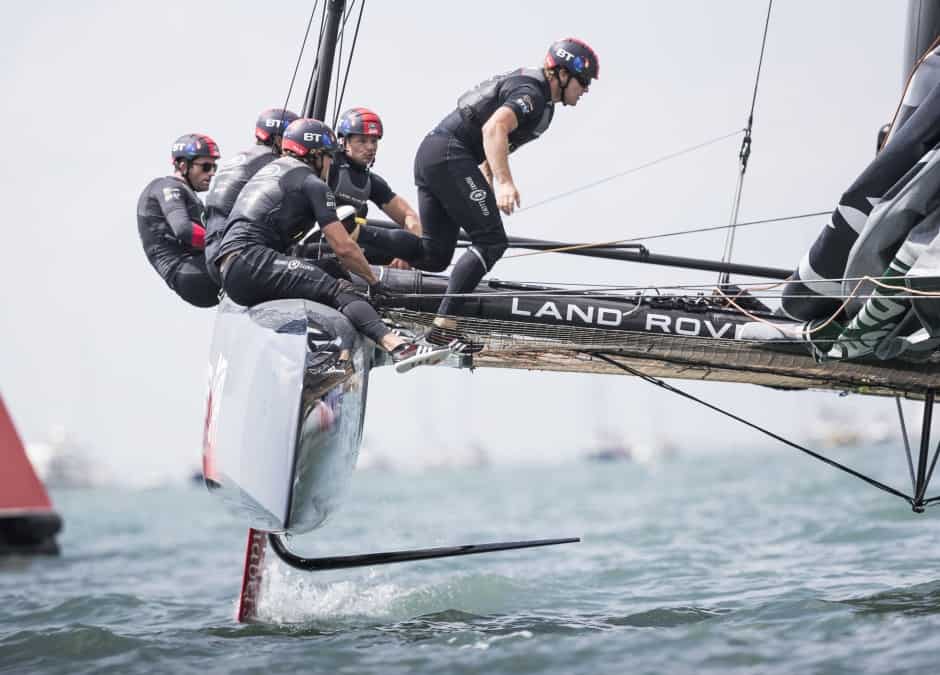
It’s a dynamic that Whitmarsh remembers well from his days in F1: “I think it’s quite amazing when you’re dealing with the best racing drivers or sailors in the world, the feeling that they have. If there’s something wrong – a vibration, a noise, a tone, a feeling, a steering load feedback – these guys are so supersensitive.
“When I started my career as an engineer I was initially incredibly dismissive of drivers but increasingly I’ve found myself having to tell engineers to listen to the driver. I find the whole dynamic very important.”
For Schofield, this feedback is a critical part of the design process that helps bring the engineers back down to earth. “The crew will often come back and say it’s too unstable,” he said. “We’re only designing for the ideal world – you’ve got to be careful that you don’t design something that is quick but so spiky in its performance that you drop off a cliff.”
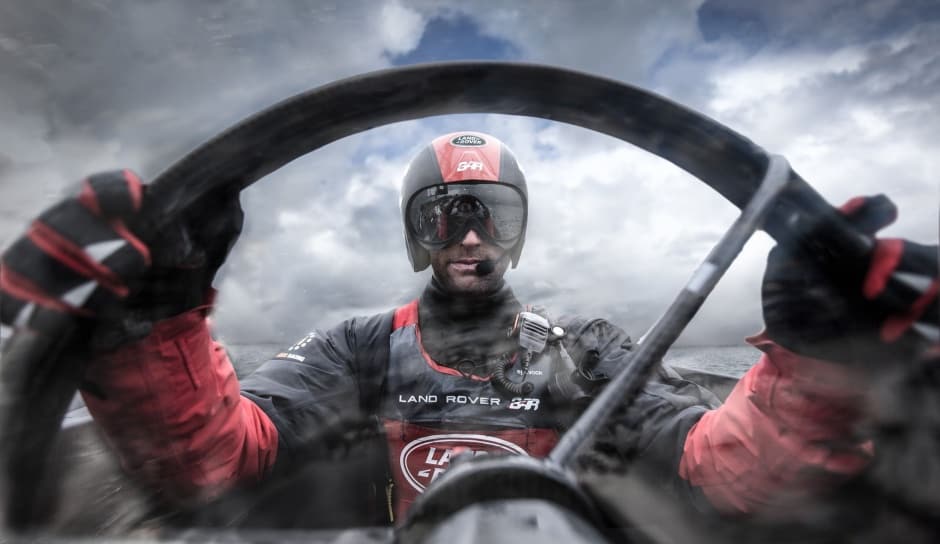
As well as the relationship between crew and the engineers, the team also works closely with a number of key industrial partners – including Jaguar Land Rover, BT, BAE Systems, Siemens, and Renishaw – through its Technical Innovation Group (TIG). “We’re quite a small organisation; the TIG allows us to reach out to much larger technical organisations looking for areas of expertise that we don’t have,” commented Whitmarsh.
One particularly notable example of industry involvement is the work the team has done with Land Rover – its main technical partner – on the boat’s 78.6ft wing. Around the same size as that that of a 757, this huge carbon-fibre structure is covered in a thin Clysar film that deforms under the load of wind, thereby modifying the flow of air over the wing and affecting its performance.
In an effort to understand this in greater detail, and to actually determine the final flying shape of the wing, the team deployed tools originally developed by main technical partner JLR for designing the roofs of convertible cars.
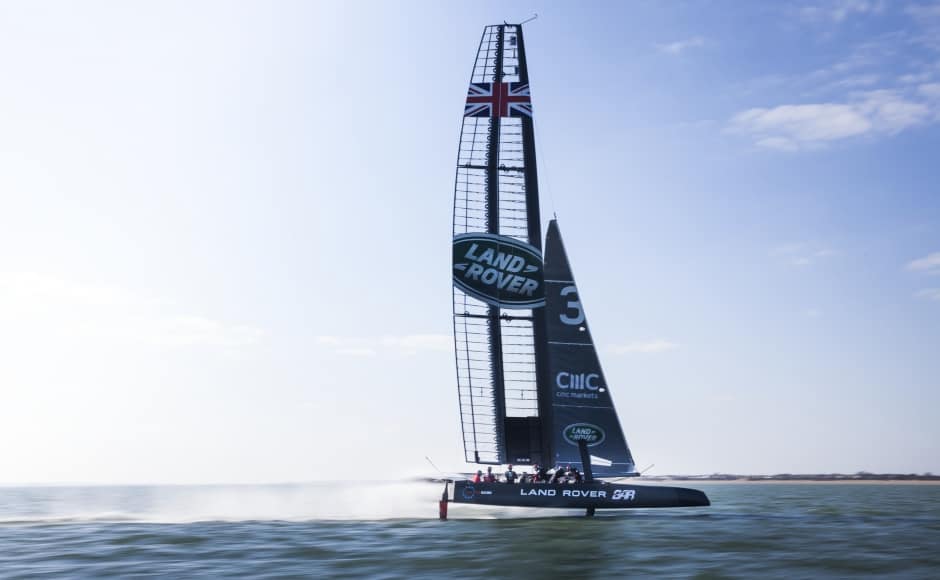
Another important relationship is with industrial giant Siemens, which has supplied an end-to-end suite of software tools that has enabled the team to create a true digital twin of the real-life boat.
According to Siemens Industry Software vice-president Robin Hancock, there’s absolutely no lag between the boat and the model, and he reckons it represents a new level of sophistication for the America’s Cup. “When you’re collaborating across a very rapid design cycle, having the right info up to date with everybody sharing it is really important. This is the first team to have that.”
Elsewhere, one particularly unusual development has seen engineers at BAE Systems adapt a battlefield communication technology based on bone conduction to help the crew communicate more effectively with each other.
This prototype headset creates physical vibrations from an audio signal, which travel through facial bones into the inner ear, where the vibrations are translated into nerve impulse signals sent to the brain. The device enables users to keep both their ears free so external sounds can be heard, while providing the ability to communicate clearly with crew mates despite the harsh and noisy conditions.
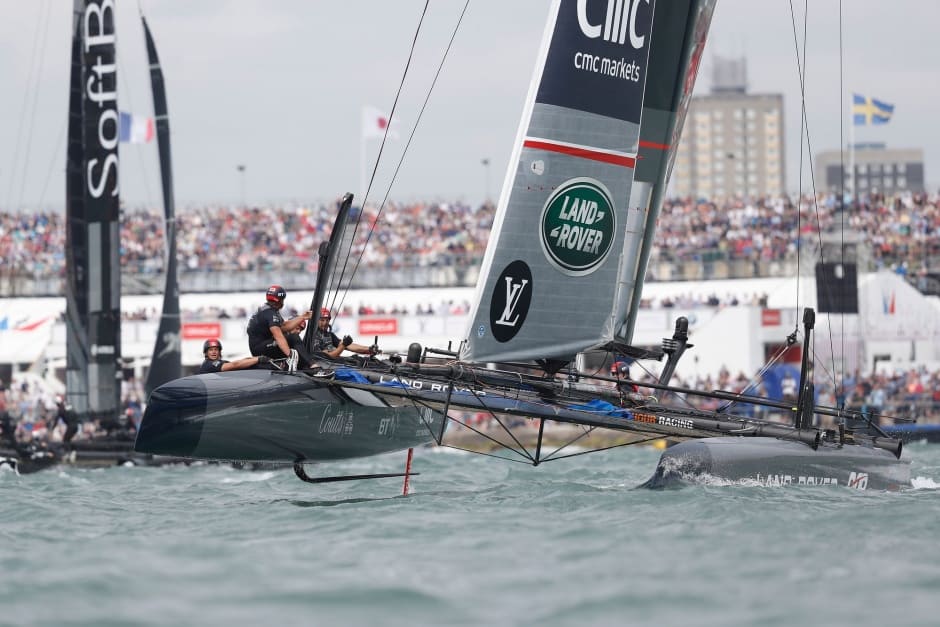
Ainslie, Whitmarsh and the Land Rover BAR team appear supremely confident that this focus on innovation will bring the America’s Cup back home. But beyond this, they hope it could lay the foundations for wider industrial success: that a triumph in Bermuda next year could set the team up as an internationally recognised hotbed of maritime innovation.
“Racing is such a fantastic environment to drive endeavour and creativity,” said Whitmarsh. “[At McLaren] we realised we’ve got a machine here that attracts really bright, ambitious, competitive people. It promotes invention, it creates IP and enables us to grow capability, so we took that from a motor-racing business with about 80 people to a business of about 3,500 people and a series of technology businesses that had been grown off the back of that. We’re very focused on trying to win the America’s Cup – that’s where our brand is going to be grown – but it’s clear to me that the marine sector is a number of years behind aero and motorsport with regards to control systems, hydraulics, simulation, analysis. I think there’s an incredible opportunity to go out and do those things.”
The history of The America's Cup
The America’s Cup has a long history and a complicated format. Although six teams are competing in its current iteration, the 35th, which culminates in 2017, the final race will be between the current holder of the trophy and a qualifying challenger.
The world’s oldest international sporting trophy, the history of the America’s Cup goes back to 1851, making it slightly older than even The Engineer. In its entire history, only four teams have won: the US, Australia, New Zealand and Switzerland. Selecting the qualifier to challenge for the trophy is a competition itself, known as the Louis Vuitton America’s Cup World Series.
This consists of a series of regattas of six races held over a weekend in international locations. The 2017 competition in fact began last year in Portsmouth, Gothenburg and Bermuda. Further races took place earlier this year in Muscat, New York and Chicago, plus a second regatta in Portsmouth. Still to come are races in Toulon and Fukuoka, Japan. Teams accumulate points during these regattas in a league system.
The regattas, which take place in a round-robin format, will yield four top challengers who will compete in a play-off – a match-racing semi-final and final in Bermuda to be held in May and June 2017. The winner of this will compete against the holder in a final pair of races in late June.
Stuart Nathan looks at how the cup's current holder, Oracle Team USA, is turning to industry for a competitive edge
Land Rover BAR isn’t alone in looking to industry to help provide a competitive edge. Indeed, the current holder of the America’s Cup, Oracle Team USA, has been working closely with aerospace giant Airbus on a host of innovations.
Speaking at Airbus’s recent Innovation Days event in Hamburg, Charles Champion, executive vice-president for engineering, commented that the synergies between sailing and flying are greater than ever.
One of the biggest of these is in materials, he said.
The skeleton of an America’s Cup boat for the 2017 races is made from carbon composite, as are increasing amounts of Airbus’s aircraft; notably the A350 series, whose wings are entirely made from composite; the wing structure is very similar to the sail wing of the yacht.
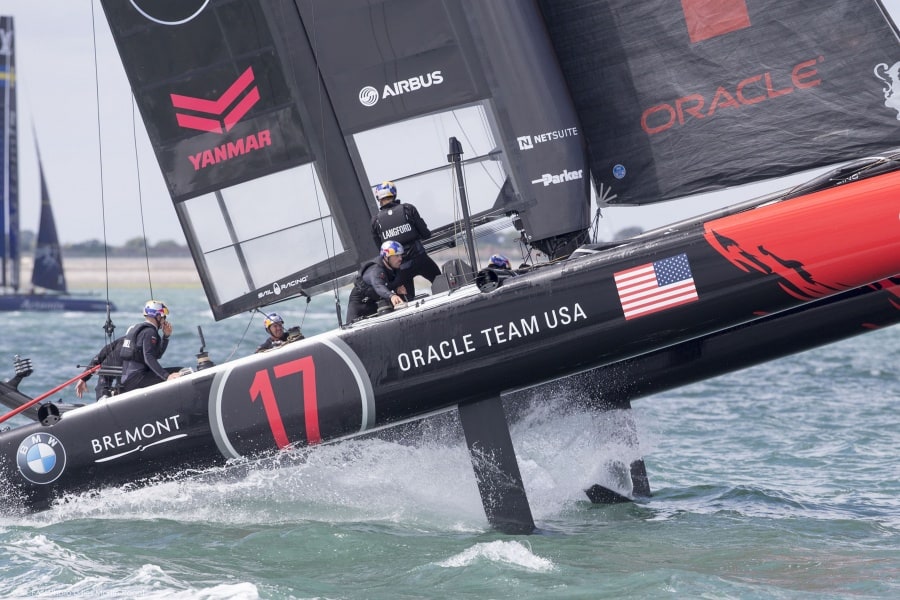
Champion said: “The use of aeronautical technology increases the boat’s performance. There are many similar challenges, these include flight qualities, aerodynamics, lightweight materials, instrumentation systems, and the fact that they are tested in the air or at sea.”
According to Champion, diversity of projects is one of the keys to delivering innovation at Airbus. By helping to deliver a step change to the sailing world, with its technologies, competencies, methods and tools, the company’s engineers gain a new perspective on their work that helps to unlock new views on how they can be used in its civil and military aerospace centres of excellence.
Some of the main areas where Airbus technology has come in useful include aerodynamic foil design and testing, hydraulics, yacht aerodynamics, 3D printing and MEMS pressure sensors.
Perhaps the most striking features of the America’s Cup boat are its dagger boards – the aerofoils that the boat rises up on at speed. Airbus found that the ideal shape was very similar to the upturned winglets it currently uses on the tips of the wings of the A350 aircraft. Like the winglets, the dagger boards have to bear extremely large loads; whereas on the wing they help to diffuse the vortices of air that form during flight, on the boat they are to support the weight of the entire craft, the force of wave impacts and the stresses incurred when the boat manoeuvres.
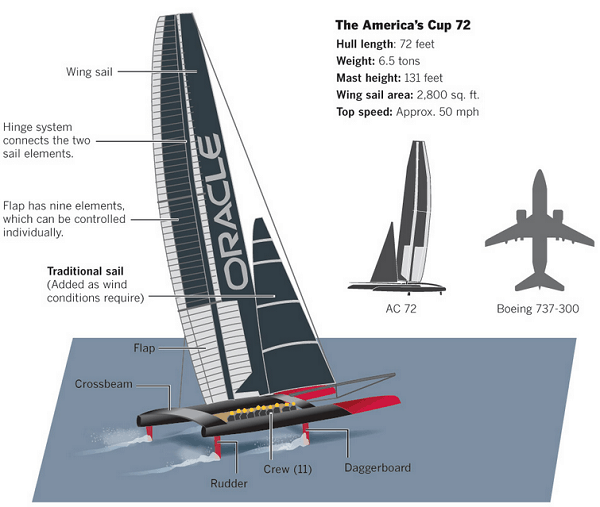
To ensure that the basic winglet structure was up to the job, the Airbus team performed two component tests at its Hamburg manufacturing facility to validate the rigidity of the structure against the strength that was required. In the process of this work, the team found that different manufacturing processes might be possible to make the winglets for the aircraft; these are now being validated.
The aerospace company’s expertise in computational fluid dynamics (CFD) was also important to the project. The data gathered during the boat design process helps the team to design a global sailing simulator, which Champion said is precisely equivalent to an aeronautical flight simulator. In the case of the boat, simulation was even more challenging because as well as the aerodynamics of the part of the boat that is out of the water it had to take into account the hydrodynamics of submerged portions: the hull sections and dagger boards.

Variables taken into account include the yacht speed, the cavitation (formation of bubbles in the water owing to the low pressure in the wake of the hydrofoil), and the hydroelasticity or deformation of the dagger board structure caused by water pressure.
Another function where aerospace technology has contributed is in sensing the strength of the wind. In conventional boats this can be done by careful and practised observation of the fabric sail, but obviously this can’t be done in a boat with no sail. Instead, Airbus provided aerodynamic pressure sensors similar to those it is now introducing onto its aircraft wings; these use MEMS devices to provide an accurate reading of air speed without having to pierce the composite structure. The leading edge of the boat’s vertical aerofoil carries eight strips of sensors, which have a variety of potential applications.
Airbus has also contributed a 3D-printed component to the Oracle boat. This component, the forward organiser, has a complex geometry and is made from aluminium. By making it with additive layer manufacturing, Airbus achieved a weight reduction of 57 per cent, reduced the production lead time and increased the component strength.




April 1886: the Brunkebergs tunnel
First ever example of a ground source heat pump?